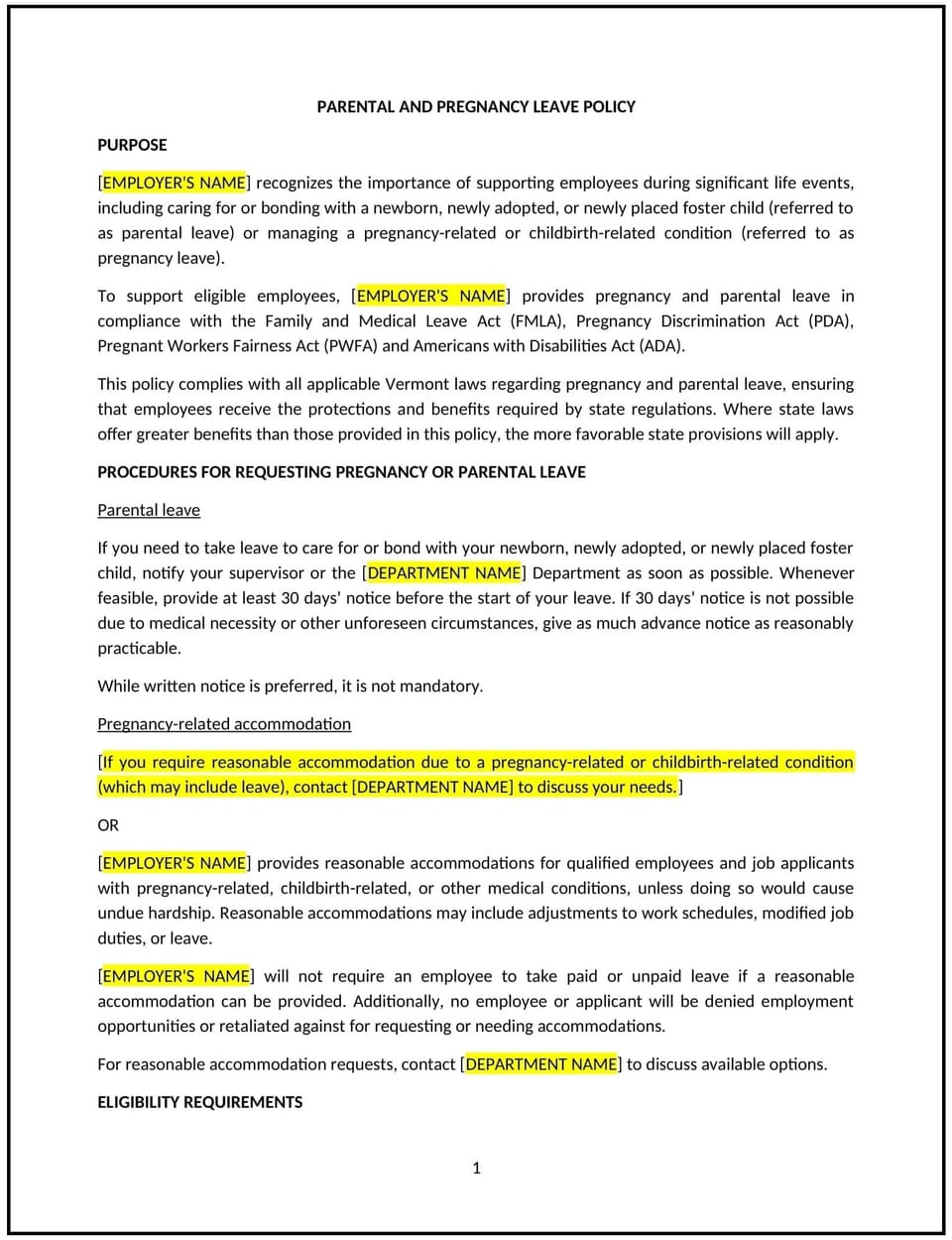Parental and pregnancy leave policy (Vermont): Free template

Parental and pregnancy leave policy (Vermont)
This parental and pregnancy leave policy is designed to help Vermont businesses provide employees with time off to prepare for and care for a new child, as well as to accommodate pregnancy-related needs. It outlines guidelines for eligibility, leave duration, and benefits, while supporting compliance with the Vermont Parental and Family Leave Act (VPFLA) and federal regulations.
By adopting this policy, businesses can support employee well-being, enhance workplace morale, and meet legal obligations.
How to use this parental and pregnancy leave policy (Vermont)
- Define eligibility: Specify eligibility criteria for leave under the VPFLA, such as the length of employment and number of hours worked.
- Outline leave types: Include provisions for pregnancy-related medical leave, parental leave for bonding with a new child, and adoption-related leave.
- Specify leave duration: Provide details on the maximum allowable leave, such as up to 12 weeks within a 12-month period under Vermont law.
- Address notification requirements: Require employees to notify HR or their manager in advance and provide any required documentation, such as a medical certificate or proof of adoption.
- Clarify pay and benefits: Explain whether leave is paid or unpaid, how accrued leave can be used, and how benefits like health insurance are maintained during the leave period.
- Include return-to-work provisions: Reinforce employees’ rights to return to the same or an equivalent position after their leave.
- Monitor compliance: Regularly review the policy to ensure alignment with Vermont laws and federal regulations.
Benefits of using this parental and pregnancy leave policy (Vermont)
This policy provides several benefits for Vermont businesses:
- Promotes compliance: Aligns with VPFLA and federal laws, reducing legal risks.
- Supports employee well-being: Helps employees balance work and family responsibilities during significant life events.
- Enhances retention: Demonstrates the company’s commitment to employee support and fosters loyalty.
- Reduces disputes: Provides clear guidelines for managing leave requests and expectations.
- Strengthens workplace morale: Shows the company values its employees and their families.
Tips for using this parental and pregnancy leave policy (Vermont)
- Communicate the policy: Share the policy with employees during onboarding and include it in the employee handbook or internal systems.
- Educate managers: Provide training on VPFLA and federal family leave requirements to ensure consistent application of the policy.
- Plan for coverage: Develop plans to manage workloads and ensure smooth operations while employees are on leave.
- Encourage early notice: Ask employees to notify HR as soon as possible to facilitate planning and minimize disruptions.
- Update regularly: Revise the policy to reflect changes in Vermont laws, federal regulations, or company practices.
Q: Who is eligible for parental and pregnancy leave under this policy?
A: Employees who meet the VPFLA requirements, such as working for the company for at least one year and completing a minimum number of hours, are eligible.
Q: What types of leave are covered under this policy?
A: This policy covers leave for pregnancy-related medical needs, bonding with a new child, and adoption-related responsibilities.
Q: Is parental and pregnancy leave paid?
A: Leave is generally unpaid under VPFLA, but employees may use accrued paid time off, such as vacation or sick leave, during their absence.
Q: How should businesses handle leave requests?
A: Employees must notify HR or their manager in advance and provide required documentation, such as a medical certificate or proof of adoption.
Q: What happens to employee benefits during leave?
A: Benefits like health insurance typically continue during leave, with employees responsible for their portion of premiums. Details are outlined in the policy.
Q: Are employees guaranteed their job after leave?
A: Yes, employees are entitled to return to the same or an equivalent position after their leave, as required by law.
Q: How often is this policy reviewed?
A: This policy is reviewed annually or whenever significant changes occur in Vermont laws or federal family leave regulations.
Q: Does this policy apply to part-time employees?
A: Eligibility for part-time employees depends on meeting the minimum hours and employment duration requirements under VPFLA.
This article contains general legal information and does not contain legal advice. Cobrief is not a law firm or a substitute for an attorney or law firm. The law is complex and changes often. For legal advice, please ask a lawyer.


